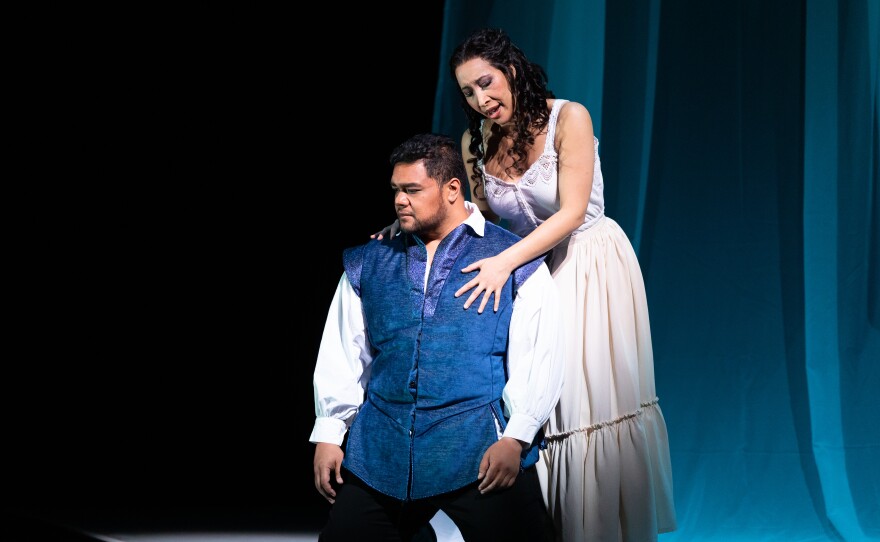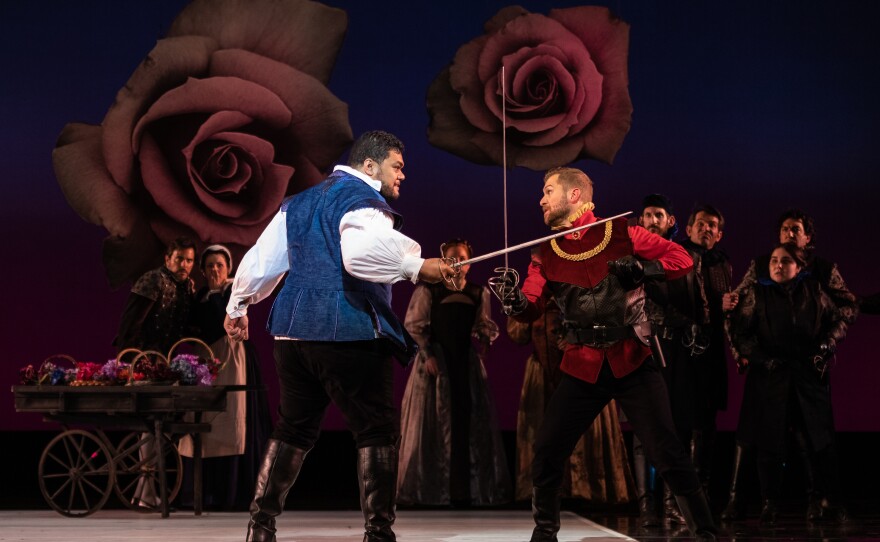San Diego Opera turns to Shakespeare's famous tale of star-crossed lovers for its second grand opera since returning to live performances at the Civic Theater. The classic French opera "Roméo et Juliette" heightens the drama of the original play in typical opera fashion.
The tragedy of Romeo and Juliet is fueled as much by the love shared by the title characters as it is by hate displayed by their feuding families. Perhaps no one in the new San Diego Opera production understands those dueling passions better than Doug Scholz-Carlson.
"I'm the intimacy director and the fight choreographer," Scholz-Carlson said. "Intimacy direction is fairly new, especially in the opera world. The intimacy director is going to handle those moments of physical intimacy, like romance, but it can also be parents and children together. It can be nonconsensual, so assaults can be part of what an intimacy director is doing. A lot of intimacy direction came out of fight direction, and a lot of the principles are the same. The biggest difference is intimacy direction is really very concerned with affirmative consent so that the performers have the chance to consent to everything that they are going to do in the course of the performance."
In the case of Roméo and Juliette, it is a progression from flirting to touching to kissing. And, in Director Matthew Ozawa’s production, the singers get to shine on a gorgeously designed but very spare set.

"The gestures that are being made by the sets and the lighting are beautiful, but they're really stark and that means the performers really can shine," Scholz-Carlson said. "So, for the intimacy, when they're coming together, they don't have a lot of set pieces that they're traveling across or anything. You're watching how the two of them are touching each other and how they're getting closer and how they kiss. The whole story is in what the performers are doing."
That goes for the intimacy of close combat in fight scenes as well.
"When you just have open space and they say, 'tell the story, use movement to tell the story on this open space,' I just find that really exciting," Scholz-Carlson said.
It’s also exciting for singer Sarah Coit, who has a "trouser" role in "Roméo et Juliette," which means she plays a male character.
"Very typical in opera," Coit said. "I'm what's called a mezzo-soprano, and a lot of mezzo-soprano roles are male characters."
RELATED: Globe's new 'Robin Hood' stages swordplay in the round
But what’s not typical for her is having to engage in swordplay.
"So we went around the room the first live rehearsal, and they asked what kind of experience we had, and I was the only one who had none," Coit recalled.
That was fine for Scholz-Carlson: "She doesn't have the specific physical vocabulary of using a sword, so that she needs to learn, and it's going to take us a little bit longer as her body gets used to all of those specific movements. If someone did have more vocabulary with the sword, then you might choreograph something that was a little bit more complicated just because they were able to execute it. But you just got to go step-by-step."
"It's very much like dance," Coit said. "It's very, very choreographed. And so it's just a matter of making sure you're focused and remembering what you're doing and staying calm."
Coit sings the role of Stéphano (a character created specifically for the opera who does not appear in Shakespeare's play). His antics lead into the big battle between Tybalt and Mercutio, which involves chorus members running around as the panicked crowd. That’s why Scholz-Carlson holds a fight call before every performance.
"In the Tybalt-Mercutio fight, we've got about 40 people running full speed in different interlocking patterns around the stage. So it's all complicated," Scholz-Carlson said. "Everybody has to do their job, right? So, before every performance, we run all of that at half speed and just check in, and then we run it at full speed so that when we get in performance, then they've tried it that night and we know that everything is accurate."
RELATED: Passions run high in San Diego Opera's 'Carmen'
Choreographing a fight for opera requires working closely with the conductor — in this case Yves Abel — and the score.
"Usually when you're choreographing a fight for a spoken play, you're going to put music underneath it, but you always fit that in after the fact," Scholz-Carlson said. "In opera, you have a defined amount of time set by the music. The music gives you a lot of the story that you want to tell. For instance, in this piece, the music gives you exactly when you want the stabs to happen because there are musical moments that you have to hit, which is really fun. There are several chords at the end of the Tybalt-Mercutio fight that could be the final stab where Mercutio gets stabbed, and Abel had a strong opinion about that."
The challenge is that the fight choreography may not be played out at full speed until just before opening, which means some tweaking may be needed at the last minute.
Abel, who described the conductor as "the musical boss," said: "Everything has to fit into my tempo — so the speed of the music. And so, if we find in the last stages that there just isn't enough music, let's say, to cover all of the different moves of the battle, then, of course, something has to be cut and it won't be the music."
Abel collaborates with Scholz-Carlson, director Ozawa and especially the singers to make sure that the opera comes together in the best way possible.
"It's my job also to push the limits as much as possible," Abel said. "I feel strongly about that, to see how far a singer can go, sometimes to the point where they look at me like they want to hit me or something, but never past that point. But I believe very strongly that going to that limit is what creates great performances."
And going to the limit of one’s passion is at the heart of the tragedy of Roméo and Juliette.
"Roméo et Juliette" opens Saturday, March, 26, with four performances at the San Diego Civic Theatre. Additional performances are March 29, April 1 and a matinee on April 3.








